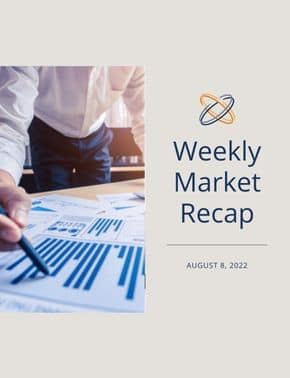Week in Review
Equity Markets:
The S&P ended the week essentially flat, up just 0.4%. Growth stocks outperformed their value counterparts, and the NASDAQ finished the week up 2.2%. The recent equity market surge is likely attributed to strong quarterly earnings results and the hope that the Fed will slow its tightening cycle amidst softening economic numbers.
So far 87% of S&P 500 companies have reported earnings. 75% have surpassed earnings expectations and 70% have beat revenue expectations, according to FactSet. The percentage of companies that have had earnings surprises has steadily increased as more reports have been released. Last week the beat rate stood at 68%. Earnings growth has also increased as the earnings season has progressed. According to FactSet, the blended earnings growth rate (this combines actual reported numbers and the estimates for companies yet to report) is currently 6.7%. At the end of the second quarter, earnings growth expectations were only 4%.
Fixed Income Markets:
Following the release of the jobs report, treasuries sold off and yields spiked. The 10-year yield ended the week at 2.83% after opening the week ~ 20 basis points lower. The bond market saw the positive jobs report as more fuel for the Fed to keep moving forward with large interest rate hikes.
Following the FOMC meeting, the bond market reacted favorably to Chairman Powell’s comments and believed future rate hikes could be slowed. Despite the negative GDP growth, the rest of the economy is still resilient.
Economic:
The highlight report for the week was the nonfarm payroll report released on Friday. The economy added 528,000 in July, which was a blowout compared to the Dow Jones estimate of 258,000. The unemployment level dropped to a pre-pandemic level of 3.5%. Wage growth increased 5.2% over the past year. These surprise labor market numbers led to a mixed reaction from the markets. A strong labor market will likely lead to the Fed keeping up the pace of rate increases for longer, which is generally not a welcome sight for the markets.
Looking Ahead
Equity Markets:
The market has rallied ~12% from the mid-June low of 3,636. “Don’t fight the Fed” was a common headline during the pandemic. Despite one of the most severe economic slowdowns in history, the market rebounded quickly and shrugged off the negative economic news. The Fed took swift monetary policy action that lowered the impacts of the economic shutdown. The current environment appears to indicate hopefulness that the Fed will once again be there to help, but the backdrop is much different from early 2020. Fed policy action will likely have a major impact on the direction of the market.
It appears the Fed will need to keep an aggressive stance as inflationary pressures remain. We believe this will keep volatility high in the equity market. Staying disciplined in your long-term portfolio construction should still be a top priority. Short-term bear market rallies are common and now is not a time for excessive risk-taking with weakening economic data, as meaningful rate hikes will likely show more impact. Systematic rebalancing is an effective tool for investors to capitalize on oversold sections of the market and can provide long-term growth opportunities.
Fixed Income Markets:
Bond market participants priced in a smaller rate hike in September by the FOMC, a decrease to 0.5% from the current increase of 0.75%. The hot July labor report and comments from other Fed members caused an about-face. The bond market appears to be pricing in another 0.75% next month. The yield curve remains in a deep inversion and more sections of the yield curve are inverting. The bond market is pricing in a small likelihood of the soft landing the Fed hopes to accomplish.
Volatility is likely to persist within the bond and equity markets. Rates took a swift path down after nearly touching 3.5%, but we still believe the 10-year will breach the 3% mark and spend the majority of the next ~12 months in that zone. The Fed is likely to remain aggressive in its quantitative tightening policy if the current inflationary pressures persist.
Economic:
Following strong jobs numbers last week, we will see timely data on the inflationary front. On Wednesday, July’s CPI report will be released. On Thursday, the Producer Price Index will be released. With the FOMC not meeting until next month, these reports could move the market in a significant way. The University of Michigan Consumer Sentiment Index will release its preliminary results on Friday.
Important Disclosures:
Investment Advisory Services offered through Krilogy®, an SEC Registered Investment Advisor. Please review all prospectuses and Krilogy’s Form ADV 2A carefully prior to investing. This is neither an offer to sell nor a solicitation of an offer to buy the securities described herein. An offering is made only by a prospectus to individuals who meet minimum suitability requirements.
All expressions of opinion are subject to change. This information is distributed for educational purposes only, and it is not to be construed as an offer, solicitation, recommendation, or endorsement of any particular security, products, or services.
Diversification does not eliminate the risk of market loss. Investments involve risk and unless otherwise stated, are not guaranteed. Investors should understand the risks involved of owning investments, including interest rate risk, credit risk and market risk. Investment risks include loss of principal and fluctuating value. There is no guarantee an investing strategy will be successful. Past performance is not a guarantee of future results. Indices are not available for direct investment; therefore, their performance does not reflect the expenses associated with the management of an actual portfolio. The S&P data is provided by Standard & Poor’s Index Services Group.
Services and products offered through Krilogy® are not insured and may lose value. Be sure to first consult with a qualified financial advisor and/or tax professional before implementing any strategy discussed herein.














